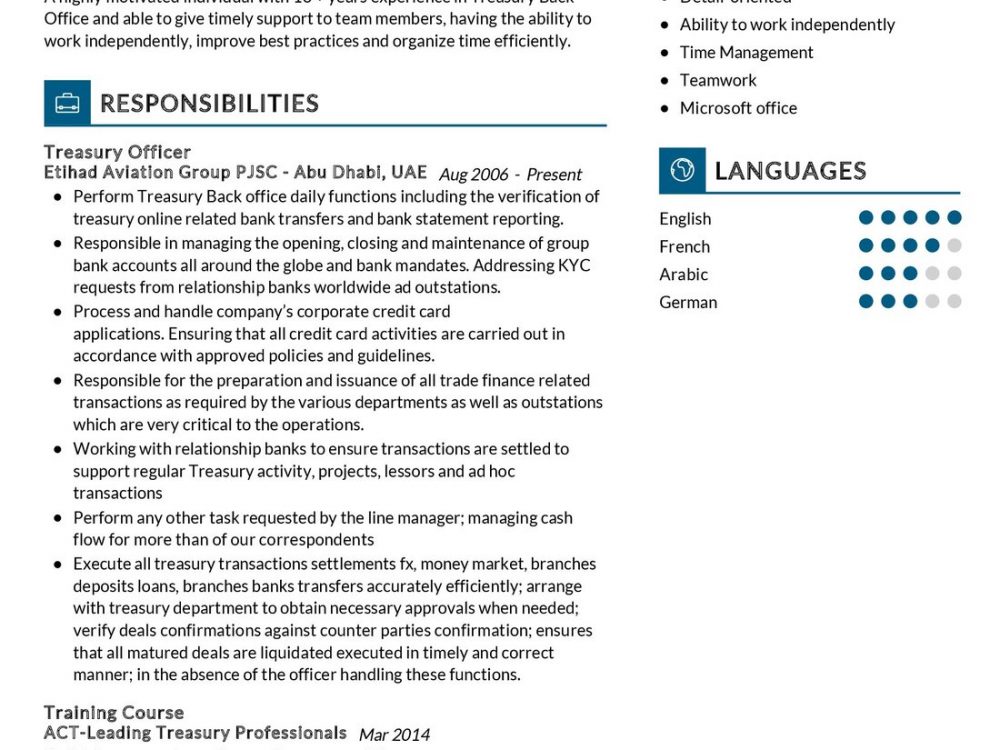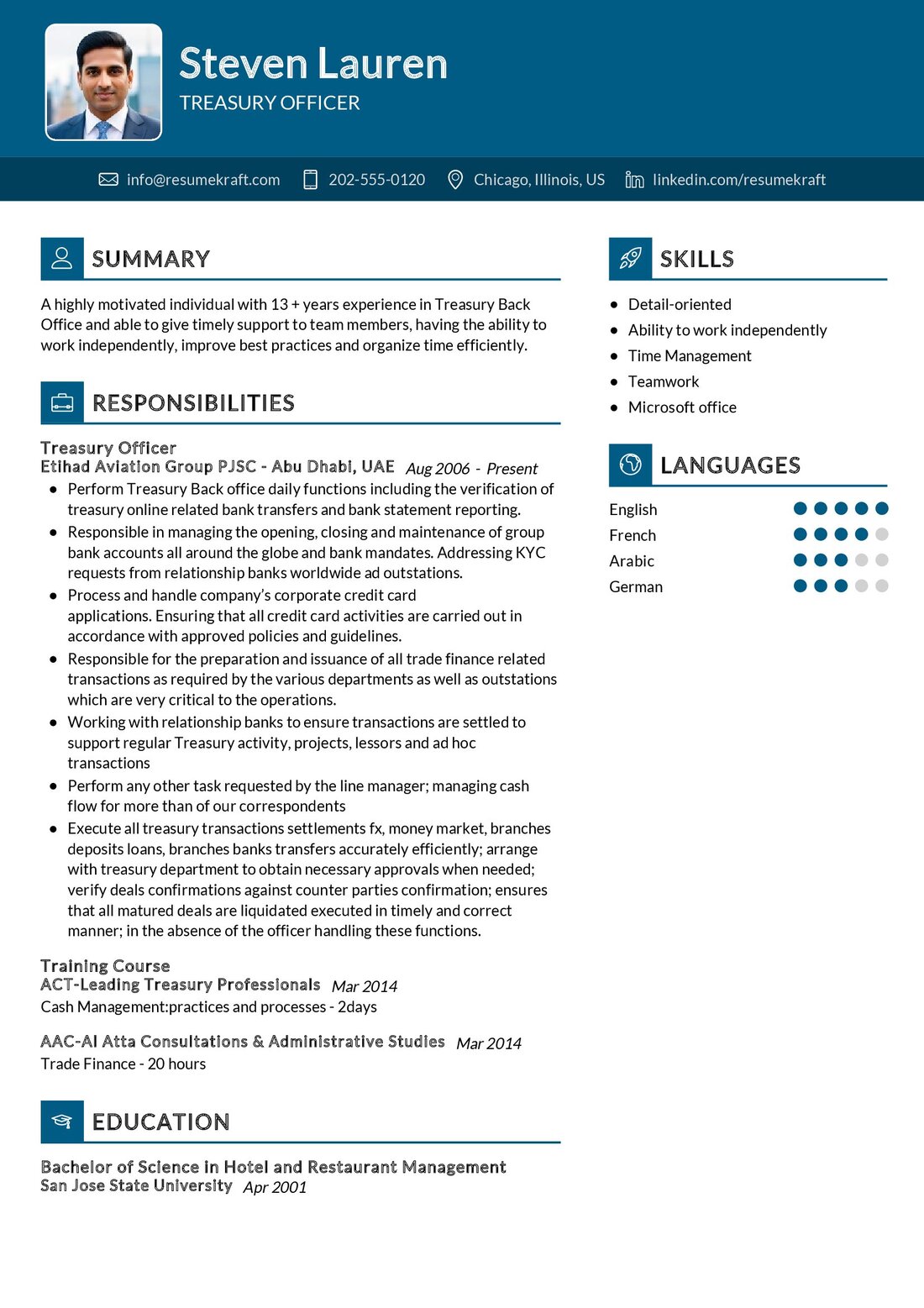Exploring the Role of a Treasury Officer
As financial landscapes continue to evolve, the position of a Treasury Officer holds increasing importance in organizations worldwide. This role requires a unique blend of financial expertise and strategic thinking, guiding the treasury team towards effective management of financial assets. Let’s delve into the multifaceted role of a Treasury Officer, a position demanding a deep understanding of financial markets, coupled with the ability to navigate complex financial scenarios.
A Treasury Officer is tasked with overseeing the organization’s liquidity, managing cash flow, and ensuring efficient financial operations. They play a crucial role in optimizing the use of financial resources, mitigating risks, and strategically planning for the future. This article will provide an in-depth exploration of the responsibilities, job requirements, and essential skills needed for a successful career as a Treasury Officer.
What are the Treasury Officer Job Requirements?
Becoming a Treasury Officer involves meeting specific requirements that showcase a strong foundation in finance and a commitment to the organization’s financial health. Let’s delve deeper into the prerequisites one needs to fulfill to embrace the role of a Treasury Officer:
- A Bachelor’s or Master’s degree in Finance, Accounting, or a related field, demonstrating a solid foundation in financial principles.
- Proven experience in financial analysis, risk management, and cash flow forecasting, showcasing a trajectory of increasing responsibility.
- Understanding of financial regulations and compliance, ensuring adherence to industry standards and legal requirements.
- Proficiency in financial software and treasury management systems, essential tools in the modern financial landscape.
- Excellent communication and interpersonal skills, as Treasury Officers often interact with internal and external stakeholders.
- Strategic thinking and problem-solving abilities, crucial in navigating the dynamic and sometimes unpredictable financial markets.
Obtaining additional certifications in financial management can enhance your profile and distinguish you in the competitive job market.
Responsibilities of a Treasury Officer
The role of a Treasury Officer is multifaceted, requiring a balance of technical expertise and strategic vision. Let’s explore the core responsibilities that define this role, each contributing to the organization’s financial well-being:
- Managing cash flow and liquidity to ensure the organization meets its financial obligations.
- Conducting financial analysis to identify risks and opportunities, providing insights for strategic decision-making.
- Implementing and overseeing cash management strategies to optimize the use of financial resources.
- Negotiating with financial institutions to secure favorable terms for loans, investments, and other financial transactions.
- Monitoring and managing the organization’s investment portfolio to maximize returns while minimizing risks.
- Collaborating with internal teams to align financial strategies with overall business objectives.
- Ensuring compliance with financial regulations and reporting requirements.
Each responsibility comes with its own set of challenges, providing opportunities for continuous learning and professional growth.
Treasury Officer Resume Writing Tips
Crafting a resume that stands out in the competitive job market is essential for aspiring Treasury Officers. Here are some tips to help you create a compelling resume that showcases your skills and experiences effectively:
- Highlight your financial achievements, showcasing instances where you contributed to improved cash flow or risk mitigation.
- Quantify your impact by including specific financial metrics, such as percentage improvements or monetary values.
- List relevant certifications, emphasizing your commitment to ongoing professional development in the finance field.
- Customize your resume for each application, aligning your skills and experiences with the specific requirements of the role.
Your resume is a snapshot of your financial journey, so make it compelling and tailored to the Treasury Officer role.
Treasury Officer Resume Summary Examples
Your resume summary serves as the opening act of your financial career story. Craft a powerful summary that encapsulates your experiences, skills, and the value you bring to the table. Here are some examples to inspire you:
- “Seasoned Treasury Officer with over a decade of experience, adept at optimizing cash flow and implementing strategic financial initiatives for organizational success.”
- “Results-driven Treasury Officer with a proven track record in risk management and financial analysis, contributing to a 15% improvement in overall financial efficiency.”
- “Experienced Treasury Officer skilled in negotiating favorable financial terms, driving profitability while ensuring compliance with regulatory standards.”
Your summary sets the tone for your resume, providing a glimpse into your financial expertise and leadership capabilities.
Create a Strong Experience Section for Your Treasury Officer Resume
Your experience section is the heart of your resume, narrating the story of your financial journey. Highlight your key achievements and showcase the impact you’ve made in previous roles. Here are some examples to guide you:
- “Led cash flow optimization initiatives, resulting in a 25% reduction in borrowing costs for the organization.”
- “Developed and implemented risk management strategies, successfully navigating the organization through economic downturns with minimal financial impact.”
- “Negotiated with financial institutions to secure a favorable line of credit, providing the organization with increased financial flexibility.”
Each experience should tell a story of challenges met, solutions found, and successes achieved in the realm of financial management.
Education Section for Your Treasury Officer Resume
Your educational background is the foundation of your financial expertise. List your academic achievements and relevant certifications to showcase your commitment to continuous learning:
- Master of Business Administration in Finance, XYZ University, a comprehensive program that deepened financial knowledge and strategic thinking, 2010.
- Bachelor of Science in Accounting, ABC University, laying the groundwork for a successful career in financial management, 2008.
- Certified Treasury Professional (CTP), a recognition of your expertise in treasury management, 2012.
Each educational qualification is a testament to your commitment to excellence in the field of finance.
Treasury Officer Skills for Your Resume
Your skill set is your toolkit, equipped with a diverse range of tools honed over the years. Showcase your abilities, both innate and acquired, with the following essential skills for a Treasury Officer:
Soft Skills:
- Strategic thinking and planning, the ability to foresee financial trends and plan accordingly.
- Effective communication, essential in conveying financial insights to diverse stakeholders.
- Analytical skills, the knack for interpreting complex financial data and making informed decisions.
- Attention to detail, ensuring accuracy in financial reporting and analysis.
- Adaptability, the ability to navigate changing financial landscapes with resilience.
Hard Skills:
- Financial modeling, the ability to create accurate representations of financial scenarios.
- Proficiency in financial software, such as ERP systems and treasury management tools.
- Risk management, the skill to identify and mitigate financial risks effectively.
- Knowledge of financial regulations, ensuring compliance with industry standards.
- Cash flow forecasting, the ability to predict and manage cash movements within the organization.
Each skill is a valuable asset in your role as a Treasury Officer, contributing to effective financial management and strategic decision-making.
Common Mistakes to Avoid When Writing a Treasury Officer Resume
Steer clear of common pitfalls that can hinder your journey to securing a Treasury Officer role. Here are mistakes to avoid in your resume:
- Avoid using a generic resume for all applications; tailor your resume to each specific job posting.
- Highlight achievements, not just responsibilities, to showcase the impact you’ve made in previous roles.
- Don’t underestimate the importance of a cover letter; use it as an opportunity to further highlight your qualifications and passion for the role.
- Balance technical jargon; ensure your resume is accessible to both finance professionals and non-experts in the field.
- Always proofread your resume to maintain a professional image and catch any errors.
Avoiding these mistakes ensures your resume is authentic and compelling, increasing your chances of landing the desired Treasury Officer position.
Key Takeaways for Your Treasury Officer Resume
As you craft your Treasury Officer resume, keep these key points in mind:
- Emphasize your financial achievements, quantifying the impact you’ve made in previous roles.
- Highlight your strategic thinking and planning skills, showcasing your ability to navigate complex financial scenarios.
- Customize your resume for each application, aligning your skills with the specific requirements of the Treasury Officer role.
- Include a section on continuous learning, showcasing relevant certifications and courses undertaken.
Remember, your resume is not just a document; it is a canvas where you paint your financial story. Best of luck!
Finally, feel free to utilize resources like AI Resume Builder, Resume Design, Resume Samples, Resume Examples, Resume Skills, Resume Help, Resume Synonyms, and Job Responsibilities to create a standout application and prepare for the Treasury Officer job interview.


